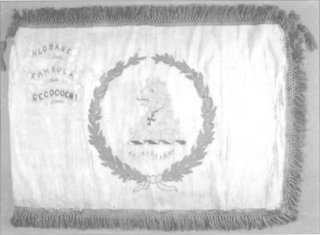

 The South African
The South African
In Ron Lock's Blood on the painted mountain (London, 1995) and his more recent note 'Riding to disaster' in Military Illustrated No 120, it was assumed that the banner of the Border Horse had been lost but this assumption is fortunately inaccurate. 'B' Troop of the Border Horse fought at the action of Hlobane in the Anglo-Zulu War on 28 March 1879 under Cmdt F A Weatherley and only Capt C C Dennison, his second-in-command, and seven men survived the disastrous rout.(2) On 5 April, Dennison, with Weatherley's elder son, Lt C PM Weatherley, who had missed both Hlobane and the action on the following day at Khambula (Nkambule), left Balte's Spruit south of Utrecht for Pretoria. Here, Dennison was given command of the Border Horse which then comprised 'A' Troop, based at Eersteling in the northern Transvaal, and another troop of 120 men recently recruited from Kimberley by Capt H Sanctuary and Capt C W Daniell, then in camp north of the town. Dennison and his men were given a warm welcome by the inhabitants and several of the ladies of Pretoria made a banner for the unit. At a parade on Klerk Plein (Church Square) in late April, the banner was presented to Dennison by Col W O Lanyon, administrator of the Transvaal and commandant of volunteer forces in the territory. The Border Horse participated in the actions against the Pedi led by Sekhukhune woaSekwati during that summer and in the final British actions in November which resulted in his capture. The unit was disbanded at Middelburg (Transvaal) in December 1879.

The banner was placed in the Anglican cathedral in Pretoria and subsequently removed to the Anglican church in Rustenburg where Dennison was living. When that church closed, it was sent to Dennison, then living in Vryburg in the Cape Colony, and in 1922 it was presented by him to the Transvaal Museum where it was accepted with the accession number HC 405. The banner was accompanied by a letter from Dennison setting out its history. It is now in the custody of the National Cultural History Museum in Pretoria. The banner is rectangular, measures about 53,5 cm by 91,5 cm and is surrounded by a tasselled border on all sides except the hoist; its shape is not that of a guidon carried by regiments of the dragoon guards. Capping the staff originally was the head of a spear (assegai) taken at Khambula on 29 March. The three honours in separate scrolls are 'Hlobane 28 March 1879', [Kambula] and 'Secocoeni 23 November 1879'. In the centre, surrounded by a laurel wreath, is a strange beast carrying a Greek Cross around its neck with the motto 'Be vigilant' underneath. Dennison describes this as the crest of Cmdt Weatherley; the Weatherley crest was 'a ram's head erased ppr'. This would be a ram's head drawn naturally with the head ripped from the body, but the neck of the beast on the banner is mounted directly on the torse and this ram, most unheraldically, has no horns. Research has failed to find a drawing of the Weatherley crest and the motto appears to be unrecorded in this form in British heraldry.(3) Perhaps the strange beast is a local rendering of the Weatherley ram by the Pretoria ladies, but its curling red tongue suggests a heraldic lion. The crest appears on the cover of Dennison's book A fight to a finish, published in London in 1904. Any trace of a Weatherley crest and information on its use would be most welcome.
Notes
1. The author is grateful to Eric Itzkin of
MuseuMAfricA, Johannesburg, and Jan van den Bos
of the National Cultural History Museum, Pretoria,
for their help in tracing the flag.
2. Jones, Huw M, 'Hlobane: A new perspective' in
Natalia, No 27 (1997), pp 42-68.
3. The author is grateful to Hugh Murray, FSA, of York
and Patricia Sheldon of the City Library, Newcastle
upon Tyne, for their help in trying to trace the crest
and motto.
Return to Journal Index OR Society's Home page
South African Military History Society / scribe@samilitaryhistory.org